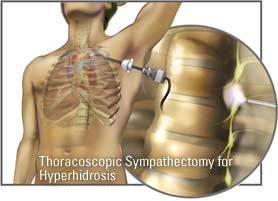Hyperhidrosis Surgery
Endoscopic Thoracic Sympathectomy (ETS) is the most (unethically) publicized treatment option for Hyperhidrosis (especially Palmar Hyperhidrosis). ETS ss the most invasive treatment option, and a Hyperhidrosis Surgery should be considered as a last resort because it frequently causes serious, irreversible side effects including compensatory sweating (excessive sweating on large areas of the body or all over), hypotension, arrhythmia, and heat intolerance.
While internet research may give a different impression, ETS is not a recommended option for hyperhidrosis because of the serious negative side effects of the procedure. ETS is banned in its country of origin (Sweden), as well s for people under 20 years in Taiwan. For inexplicable reason, it remains the most promoted treatment option on internet and is largely an unregulated procedure.
How Hyperhidrosis Surgery Works
In simple terms – the ETS process is supposed to work by blocking the transmission of nerve signals (from sympathetic nerve system) from the spinal column to the sweat glands and to thus prevent these nerve signals from “turning on” the sweat glands.
The procedure is performed with the patient under general anesthesia. An incision is made either through the axilla or just below the clavicle, and a miniature camera is inserted into the chest under the armpit. The surgeons then cut or destroy the nerve paths associated with the overactive sweat glands – this requires collapsing of the lungs on both sides one by one.

Hyperhidrosis Surgery ETS
Side Effects of Surgery for Hyperhidrosis (ETS)
Exact results of ETS are impossible to predict, because of considerable anatomic variation in nerve function from one patient to the next, and also because of variations in surgical technique. The autonomic nervous system is not anatomically exact and connections might exist which are unpredictably effected when the nerves are disabled. At the end of the day, the surgeon is cutting off a part of your central nervous system, and there are a million things that may go wrong – sometimes with tragic consequences.
The most common drawback to hyperhidrosis surgery is compensatory sweating in a different part of the body – this happens almost invariably, Compensatory sweating is excessive sweating that occurs on the back, chest, abdomen, legs, face, and/or buttocks as a result of ETS surgery. It can be equally or even more extreme than the original sweating problem.
Thoracic sympathectomy may also distort many bodily functions, including sweating, vascular responses, heart rate, heart stroke volume, thyroid, lung volume, pupil dilation, skin temperature and other aspects of the autonomic nervous system, like the essential fight-or-flight response. It reduces the physiological responses to strong emotions, such as fear and laughter, diminishes the body’s physical reaction to both pain and pleasure, and inhibits cutaneous sensations such as goose bumps. In some cases, a decrease in sexual arousal or even impotency has been reported by ETS patients.
Other common side effect of ETS include:
- Reduction in heart rate: While for the majority of patients this is of no consequence, patients who have an abnormally low heart rate or problem with their heart’s electrical conduction system may be severely affected. Patients that are highly competitive athletes that may require compensatory increase in heart rate or vascular tone with exercise are also impacted.
- Gustatory sweating – Patients who develop this problem note increased sweating when they are eating. This occurs in approximately 1% of patients
- Horner’s syndrome – When this occurs, the patient notes three findings on the side of the face where the stellate ganglion was injured. These include a slight droop in the eyelid, a small or narrow pupil, and the lack of sweating on that side of the face.
Reversible Surgery for Hyperhidrosis: Endoscopic Sympathetic Blockade (ESB)
ETS surgery for hyperhidrosis is irreversible, as are most of its side-effects.
Another technique, the clamping method, referred to as ‘endoscopic sympathetic blockade’ (ESB) employs titanium clamps around the nerve tissue, and was developed to make the procedure reversible. Reversal of the clamping procedure must be performed within a short time (few days) after clamping. Evidence indicates that the recovery is not complete and some of the side effects will continue post reversal.
Hyperhidrosis Surgery (ETS) – Key Considerations
The ETS process is generally irreversible, and comes with non-trivial risks of side effects. Moreover, its very expensive and any potential gains in reduction in sweat on palms are often more than compensated by sweating on other body parts. Combined with the largely commercial interest fueled information on internet and the unethical medical professionals not explaining the full risks of hyperhidrosis surgery to their patients, it is difficult to recommend hyperhidrosis surgery as an option for hyperhidrosis treatment.
This should be considered as the last resort, and even then, the potential benefits need to be weighted carefully against the potential side effect. There are several other safer option available that may work for most of the patients. Our advise – DO NOT do it.


1 Comment
Pingback: Hyperhidrosis Network | Hyperhidrosis Treatments: Comparison - Hyperhidrosis Network